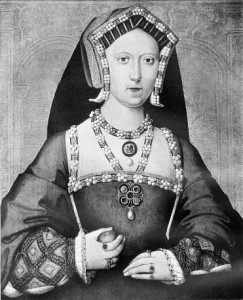
Henry VIII wrote to Pope Leo X on 12th August 1514 regarding the peace treaty agreed between France and England, which included the marriage of Mary and Louis, and mentioning her previous betrothal to Charles of Castile, the future Charles V, Holy Roman Emperor:
“The Princess Mary is to be given in marriage to France. She had been betrothed at thirteen years of age to the Prince of Castile, then nine years old, on the stipulation that when he was fourteen he should send his proxies to England, and solemnly espouse her per verba de prœsenti. His governors neglected it, and last year when the King was at Lisle, [and again] on the 15th May last he impressed this matter frequently on their attention without effect. Taking the advice of his Council, his sister solemnly annulled the engagement, and was betrothed to the King of France. Thinks their alliance will be of great importance to the weal of Christendom, and they can now turn their arms against its common enemies.”
The eighteen-year-old Mary was present at the wedding ceremony, but fifty-two-year-old Louis was represented by the Duke of Longueville. Here is the record of the marriage from Letters & Papers:
“Notarial instrument stating that, 13 Aug. 1514, at the royal manor of Greenwich, present Henry VIII., Queen Katharine, the Abp. of Canterbury, Thomas postulate of York, the Dukes of Buckingham, Norfolk and Suffolk, the Bishops of Winchester and Durham, the Marquis of Dorset, the Earls of Shrewsbury, Surrey, Essex and Worcester, John de Selva and Thomas Bohier, appeared the Princess Mary and the Duke of Longueville, and after a Latin speech by the Archbishop and John de Selva, and the reading of the French King’s letters patent by the Bp. of Durham, the Duke of Longueville, taking with his right the right hand of the Princess Mary, read the French King’s words of espousal (recited) in French. Then the Princess, taking the right hand of the Duke of Longueville, read her part of the contract (recited) in the same tongue. Then the Duke of Longueville signed the schedule and delivered it for signature to the Princess Mary, who signed Marye; after which the Duke delivered the Princess a gold ring, which the Princess placed on the fourth finger of her right hand. Louis XII.’s commission recited (dated St. Germain en Laye 8 Aug. 1514). Attested by Robert Toneys and William Edwardis.”
The real wedding took place on 9th October 1514 at Abbeville in France. Anne Boleyn was recalled from Margaret of Austria’s court to serve Mary in France, which she did until Mary returned to England following Louis’ death. Anne was retained by the new French queen, Queen Claude, wife of Francis I.
Notes and Sources
- ‘Henry VIII: August 1514, 1-15’, in Letters and Papers, Foreign and Domestic, Henry VIII, Volume 1, 1509-1514, ed. J S Brewer (London, 1920), pp. 1331-1347, 3139 and 3146. British History Online http://www.british-history.ac.uk/letters-papers-hen8/vol1/pp1331-1347.